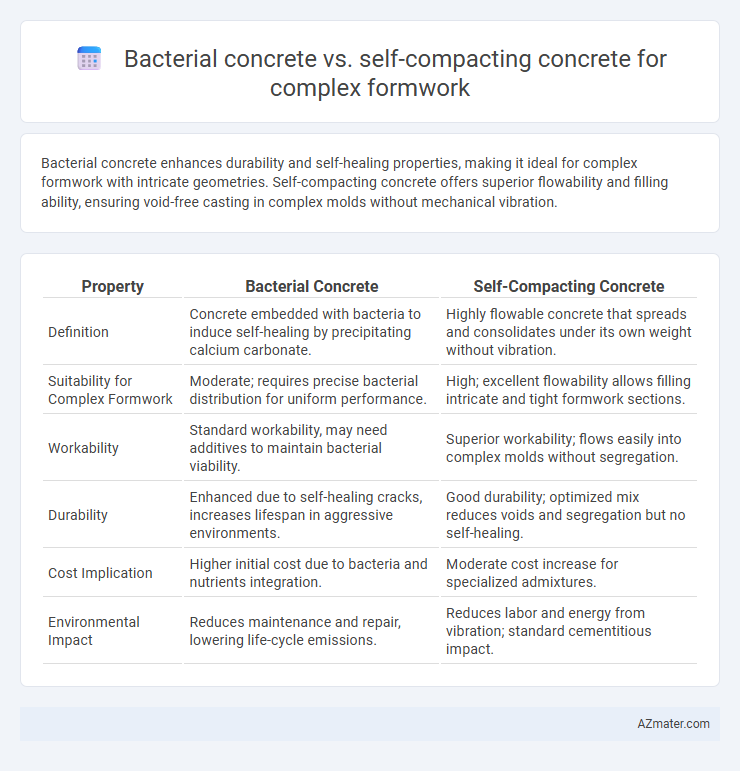Bacterial concrete enhances durability and self-healing properties, making it ideal for complex formwork with intricate geometries. Self-compacting concrete offers superior flowability and filling ability, ensuring void-free casting in complex molds without mechanical vibration.
Table of Comparison
| Property | Bacterial Concrete | Self-Compacting Concrete |
|---|---|---|
| Definition | Concrete embedded with bacteria to induce self-healing by precipitating calcium carbonate. | Highly flowable concrete that spreads and consolidates under its own weight without vibration. |
| Suitability for Complex Formwork | Moderate; requires precise bacterial distribution for uniform performance. | High; excellent flowability allows filling intricate and tight formwork sections. |
| Workability | Standard workability, may need additives to maintain bacterial viability. | Superior workability; flows easily into complex molds without segregation. |
| Durability | Enhanced due to self-healing cracks, increases lifespan in aggressive environments. | Good durability; optimized mix reduces voids and segregation but no self-healing. |
| Cost Implication | Higher initial cost due to bacteria and nutrients integration. | Moderate cost increase for specialized admixtures. |
| Environmental Impact | Reduces maintenance and repair, lowering life-cycle emissions. | Reduces labor and energy from vibration; standard cementitious impact. |
Introduction to Bacterial Concrete and Self-Compacting Concrete
Bacterial concrete incorporates specific bacteria that precipitate calcite to autonomously heal cracks, enhancing durability and longevity in complex formwork applications. Self-compacting concrete (SCC) is characterized by its high flowability and ability to fill intricate molds without mechanical vibration, optimizing projects with detailed or densely reinforced structures. Both materials address challenges in complex formwork, with bacterial concrete focusing on self-healing properties and SCC emphasizing ease of placement and surface finish quality.
Understanding Complex Formwork Challenges
Bacterial concrete offers self-healing properties that enhance durability in complex formwork by reducing micro-cracks and improving structural longevity. Self-compacting concrete provides superior flowability and filling ability, ensuring complete mold penetration without mechanical vibration in intricate formwork designs. Understanding the challenges of complex formwork involves balancing the benefits of bacterial concrete's crack resistance with the ease of placement and uniformity achieved by self-compacting concrete.
Material Composition: Bacterial vs Self-Compacting Concrete
Bacterial concrete incorporates specific bacteria strains and nutrients within the cementitious matrix to enhance self-healing and durability, while self-compacting concrete (SCC) relies on a carefully balanced mixture of fine aggregates, high-range water reducers, and viscosity modifiers for fluidity and workability in complex formwork. The bacterial concrete's unique bio-mineral formation contributes to crack sealing, whereas SCC's optimized particle packing and rheological properties ensure uniform flow without segregation or compaction effort. Material composition differences are critical in addressing structural longevity versus ease of placement in intricate molds.
Workability and Flow Characteristics in Intricate Molds
Bacterial concrete enhances durability by self-healing micro-cracks but poses challenges in workability due to the incorporation of bio-agents and nutrient carriers, potentially affecting flow in intricate molds. Self-compacting concrete (SCC) exhibits superior flow characteristics and excellent workability, allowing it to fill complex formwork with minimal vibration, ensuring uniformity in detailed molds. For complex formworks demanding precise flow behavior and easy placement, SCC is generally preferred over bacterial concrete for optimal casting performance.
Strength and Durability Comparison
Bacterial concrete enhances strength and durability through microbial-induced calcite precipitation, which fills micro-cracks and reduces permeability, leading to improved resistance against environmental stresses. Self-compacting concrete (SCC) offers high initial strength and uniform compaction in complex formwork due to its flowable nature, but may exhibit comparatively lower long-term durability without additional treatments. For complex formwork, bacterial concrete provides superior crack resistance and longevity, whereas SCC excels in ease of placement and consistent strength development.
Self-Healing Capabilities in Complex Structures
Self-compacting concrete (SCC) offers superior flowability and ease of placement in complex formwork compared to bacterial concrete, which integrates microorganisms for self-healing. SCC's self-healing capabilities primarily rely on its dense microstructure, reducing crack formation and enhancing durability in intricate geometries where bacterial activity might be uneven. The uniform consistency of SCC ensures more reliable crack sealing and structural integrity in complex shapes than the variable biological processes in bacterial concrete.
Construction Efficiency and Time-Saving Aspects
Bacterial concrete enhances construction efficiency by enabling self-healing properties that reduce maintenance time and extend structural durability, particularly useful in complex formwork where traditional repairs are challenging. Self-compacting concrete (SCC) significantly reduces labor and compaction time due to its high fluidity and ability to fill intricate molds without vibration, accelerating project timelines in complex formwork applications. While bacterial concrete focuses on long-term durability and reduced repair interventions, SCC optimizes immediate construction speed and surface finish quality for complex architectural forms.
Environmental Impact and Sustainability
Bacterial concrete leverages microbial-induced calcite precipitation to heal cracks, significantly enhancing durability and reducing the need for repairs, which lowers long-term environmental impact by minimizing resource consumption and waste generation. Self-compacting concrete (SCC) offers superior flowability for complex formwork, decreasing labor and energy use during casting, but its reliance on high cement content can increase carbon emissions, challenging sustainability goals. Incorporating bacterial concrete into SCC formulations can optimize performance while promoting eco-friendly construction practices through reduced cement usage and enhanced lifespan.
Cost Analysis for Complex Formwork Projects
Bacterial concrete reduces costs in complex formwork projects by enhancing durability and self-healing properties, minimizing repair and maintenance expenses over time. Self-compacting concrete offers labor savings and faster project completion due to its high flowability, which eliminates the need for vibration and simplifies placement in intricate molds. Comparing both, bacterial concrete may incur higher initial material costs but lowers long-term lifecycle costs, while self-compacting concrete provides immediate cost benefits in formwork handling and labor efficiency.
Best Applications and Recommendations
Bacterial concrete enhances durability and crack resistance in complex formwork, making it ideal for structures exposed to harsh environments and requiring self-healing properties. Self-compacting concrete offers superior flowability and ease of placement without vibration, optimal for intricate or heavily reinforced formworks where maintaining surface finish quality is critical. For complex geometries demanding rapid construction and minimal labor, self-compacting concrete is recommended, while bacterial concrete suits long-term structural integrity and sustainability goals.

Infographic: Bacterial concrete vs Self-compacting concrete for Complex formwork
 azmater.com
azmater.com